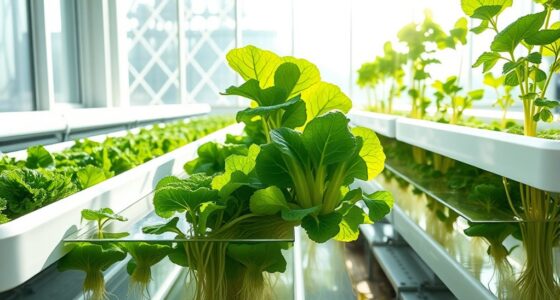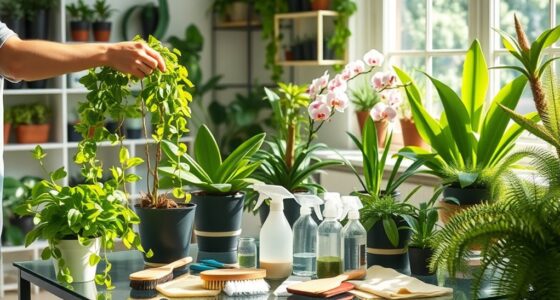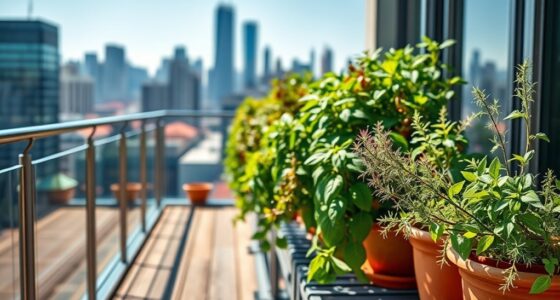If you want to grow herbs indoors year-round with little fuss, start with easy options like mint, basil, thyme, parsley, chives, oregano, sage, bay laurel, rosemary, and lemongrass. These herbs thrive in bright, sunny spots or with grow lights and need well-draining soil and regular but moderate watering. Proper pruning helps keep them healthy and productive. Keep exploring this list to discover simple tips and tricks for thriving indoor herb gardens.
Key Takeaways
- Many herbs like basil, mint, and parsley thrive indoors with minimal care when given adequate sunlight and well-draining soil.
- Herbs requiring full sun, such as thyme, oregano, and sage, grow best near south-facing windows or with supplemental grow lights.
- Proper watering—allowing soil to dry slightly between watering—prevents overwatering and promotes healthy growth for most herbs.
- Regular pruning and removing flowering stems encourage bushier, more vigorous plants and maintain optimal flavor.
- Using deep pots with drainage holes and grouping herbs improves air circulation and overall indoor growing success.
Rosemary

Have you ever wondered how easy it’s to grow rosemary indoors? With a little attention, you can enjoy fresh rosemary year-round in your indoor herb garden. This drought-tolerant herb loves full sun, so place it near south-facing windows where it can get at least six hours of direct sunlight daily. Use well-draining soil, like sandy or rocky mix, to prevent root rot. Regular pruning keeps your rosemary bushy and prevents it from becoming woody and leggy. Water sparingly, allowing the soil to dry out completely between drinks, especially during winter. Good air circulation is essential to keep your rosemary healthy and free of disease. Additionally, understanding environmental considerations can help you maintain a sustainable and healthy indoor garden. Maintaining proper humidity levels is also key to preventing issues like leaf drop and ensuring your rosemary thrives indoors. Incorporating suitable watering practices can further promote healthy growth and prevent overwatering or underwatering. Being aware of plant health monitoring techniques can help you catch any problems early and keep your rosemary thriving. With minimal fertilization and proper care, rosemary is one of the easiest herbs to grow indoors.
Mint
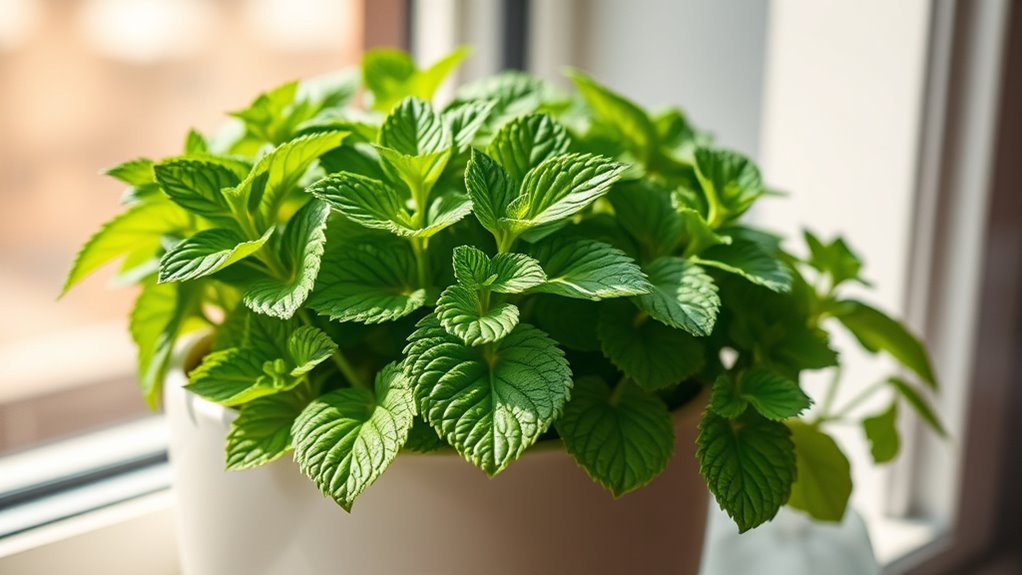
Mint needs bright, indirect sunlight from east- or west-facing windows to grow well indoors. Keep the soil moist with regular watering, but avoid overwatering to prevent root rot. Use a container with good drainage and well-draining soil to control its vigorous spread. Additionally, monitoring plant health and providing proper care can help ensure your mint thrives year-round indoors. Ensuring proper watering practices is essential, as overwatering can lead to root issues. Incorporating suitable container choices can further promote healthy growth and ease maintenance.
Optimal Light Conditions
To keep your indoor mint healthy and flavorful, providing the right amount of light is essential. Mint thrives best in bright, indirect sunlight, making east- or west-facing windows ideal. While natural light is preferable, if sunlight isn’t sufficient, you can supplement with grow lights to guarantee your plant gets the adequate light it needs. Mint can tolerate lower light conditions, but insufficient light can cause legginess and diminish its aroma. Proper light conditions also help prevent pests and diseases, ensuring your mint remains healthy year-round. Additionally, understanding the lighting requirements for herbs can help optimize their growth and flavor. Ensuring your mint receives proper light exposure can also boost its overall health and aromatic quality, making it more enjoyable to use in your culinary creations. Maintaining consistent light levels is crucial for preventing stress and promoting lush, vigorous growth. Consistent lighting also plays a role in preventing plant stress, which can lead to weaker growth or susceptibility to pests.
Proper Watering Techniques
Ensuring proper watering is essential for keeping your indoor mint healthy. You should water when the top inch of soil feels dry to the touch, maintaining consistent moisture without waterlogging. Use pots with drainage holes to allow excess water to escape, preventing waterlogged soil that can cause root rot. During winter, reduce watering frequency but never let the soil dry out completely. Keep the soil evenly moist by watering deeply until water drains from the bottom, then empty any excess from saucers. Avoid overwatering, as soggy soil weakens roots and encourages fungal diseases. Proper watering balances moisture levels, ensuring your mint stays vibrant and healthy without risking damage from overwatering or poor drainage. Additionally, understanding self watering planters can help maintain consistent moisture and reduce the frequency of watering, making it easier to care for your indoor herbs. Being aware of watering frequency based on your plant’s environment can further optimize growth and health. Monitoring soil moisture with a moisture meter can provide additional guidance for ideal watering practices.
Container and Soil Needs
Choosing the right container and soil is essential for healthy mint growth indoors. Select a deep, wide pot with drainage holes to accommodate its vigorous, spreading roots and guarantee excess water escapes.
Use a high-quality, well-draining potting mix formulated for herbs or vegetables to prevent waterlogging. The soil should feel moist but not soggy; check regularly, and when the soil feels dry, it’s time to water. Proper soil drainage is crucial for preventing root rot and maintaining healthy plant roots.
Incorporating gravel or small stones at the bottom of the container can improve drainage and reduce overwatering risks. Additionally, selecting containers with adequate drainage holes ensures excess water can escape efficiently, supporting healthy root systems. Understanding watering frequency can help you maintain optimal moisture levels for your mint plants.
Choosing containers at least 6-8 inches deep supports healthy root development and helps prevent root-bound conditions. Proper container and soil choices promote vigorous, healthy growth, making container gardening mint an easy and rewarding experience indoors. Additionally, understanding hackathons can inspire innovative ways to optimize your indoor gardening setup and troubleshoot challenges creatively.
Thyme
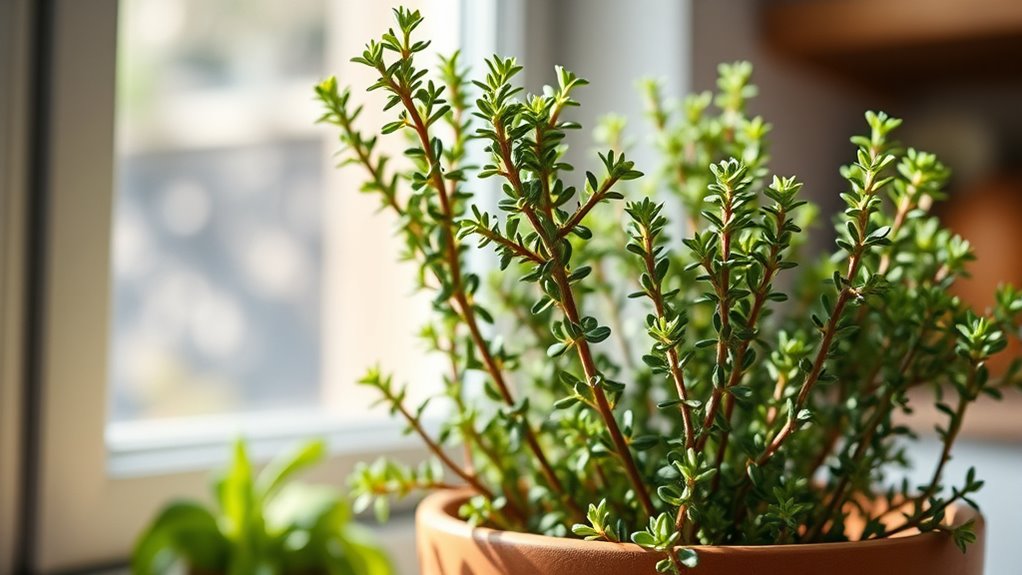
Thyme is a low-maintenance herb that thrives with minimal care, making it perfect for indoor growing. It prefers full sun and well-drained soil, needing only occasional watering when the topsoil dries out. Proper location and installation considerations, such as ensuring adequate light and well-draining soil, help promote healthy growth. Regular pruning and easy propagation from cuttings help keep your thyme healthy and lush year-round. Additionally, understanding astrological signs and their influence on personality traits can be an interesting way to connect with your plants and personalize your gardening experience.
Easy Care Tips
Because it’s hardy and drought-tolerant, thyme is one of the easiest herbs to care for indoors. It thrives in full sun and prefers well-drained soil, such as sandy or rocky mixes, making indoor gardening straightforward.
Its watering needs are minimal; just water enough to keep the soil slightly dry between waterings to prevent overwatering and root rot.
Regular pruning encourages bushier growth and prevents the plant from becoming woody or leggy, keeping it healthy and productive.
Propagation is simple—cuttings or dividing established plants work well for expanding your herb garden year-round.
Use pots with drainage holes to ensure excess water escapes.
With these easy care tips, thyme remains a reliable, low-maintenance herb perfect for indoor growing.
Optimal Growing Conditions
To guarantee your indoor thyme thrives, providing the right growing conditions is key. Ensure it receives full sun, ideally at least 6 hours of direct sunlight daily, which is crucial for healthy growth.
Use well-draining soil, such as sandy or rocky, to prevent root rot and mimic its natural Mediterranean environment.
Adjust your watering frequency by allowing the top inch of soil to dry out between waterings; thyme tolerates drought well, and overwatering can cause fungal issues.
Maintain room temperatures between 65-75°F and keep thyme away from cold drafts or temperature fluctuations.
Regular pruning encourages bushier growth and prevents woody stems—trim back about one-third every few weeks.
A good light source and careful watering are essential for thriving indoor thyme.
Parsley
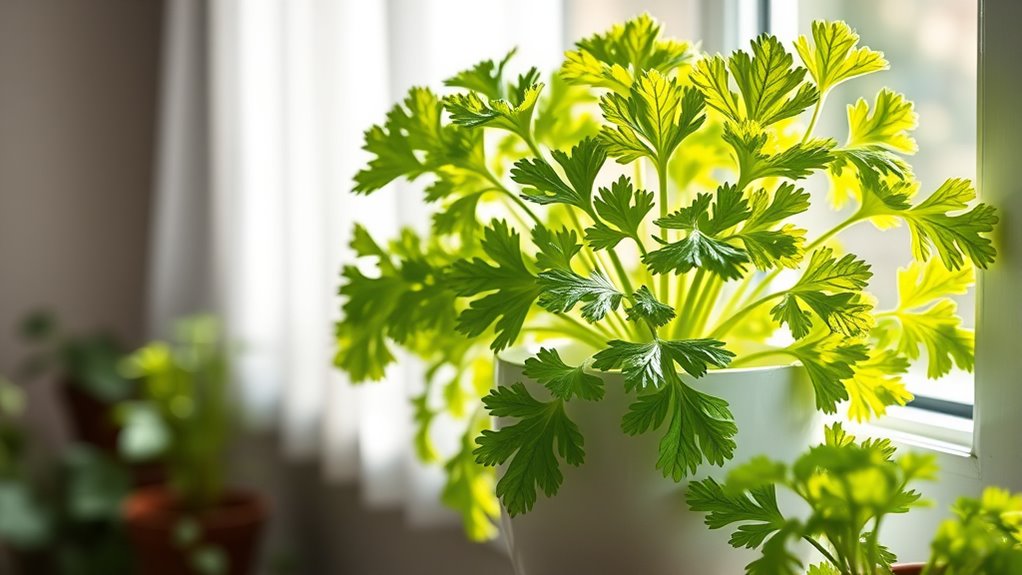
Parsley is a versatile biennial herb that can thrive indoors with proper care and often lasts for two years without needing replanting.
If you want to grow indoors, place your parsley in a sunny spot, such as east- or west-facing windows, where it can get plenty of sunlight. While it prefers full sun, it can tolerate partial shade, though growth may slow.
Use well-draining, nutrient-rich potting soil to keep your herbs healthy and avoid root rot. Keep the soil consistently moist and maintain indoor temperatures between 65-70°F for ideal growth.
Regular harvesting by pinching leaves encourages bushier growth and prevents flowering, which can reduce flavor.
With these simple steps, you’ll enjoy fresh parsley year-round in your indoor gardening space.
Chives
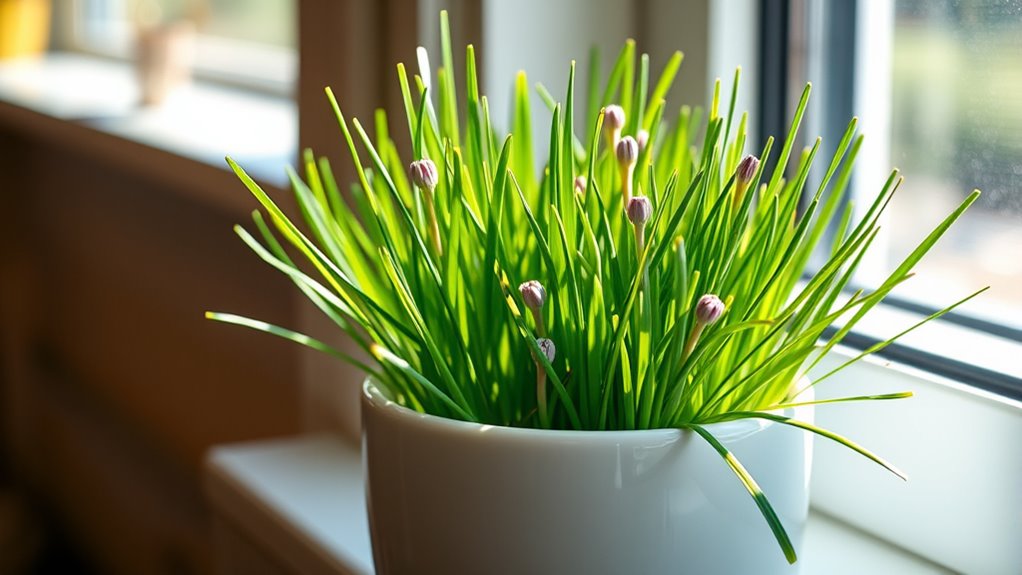
Chives are a hardy perennial herb that thrive indoors and can be harvested multiple times throughout the year. To grow chives successfully inside, place them in a sunny spot or near a south-facing window where they’ll get at least six hours of direct sunlight daily.
Use well-draining soil to prevent overwatering and keep the roots healthy. Water your chives when the top inch of soil feels dry, ensuring they don’t sit in soggy soil.
Regularly snip their slender, grass-like leaves to encourage fuller growth and to prevent flowering. The edible purple flowers add visual appeal and flavor, making chives a versatile herb for your indoor garden.
With proper light, soil, and watering, chives are easy to grow and maintain indoors year-round.
Lemongrass
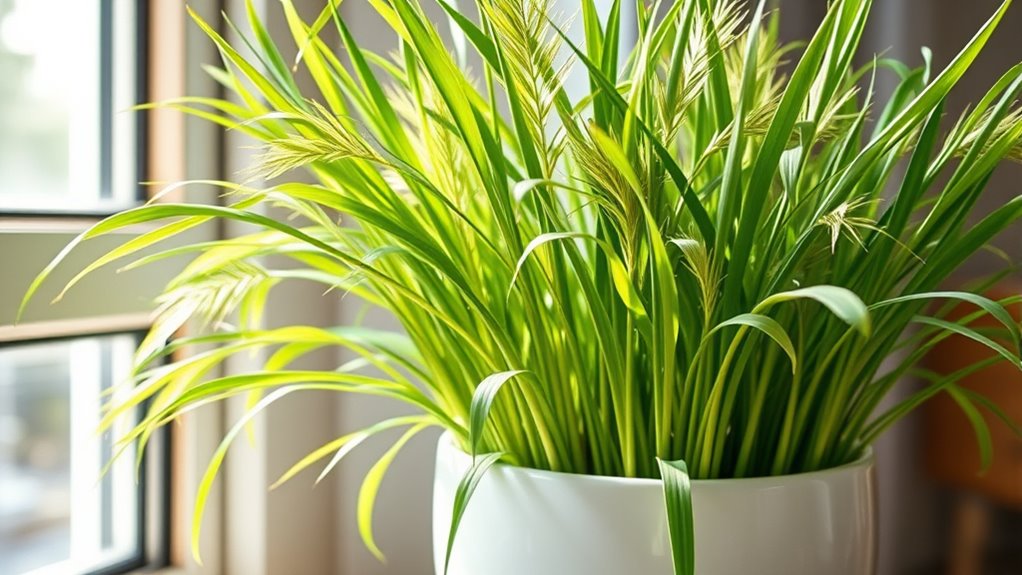
Lemongrass thrives indoors when placed in a bright, sunny spot that receives at least six hours of direct sunlight daily. This herb needs good sunlight to grow tall and healthy, making it ideal for indoor gardening in well-lit kitchens or sunrooms.
Lemongrass prefers consistently moist, well-drained soil; avoid letting it sit in water to prevent root rot. Regular watering keeps the soil evenly moist, supporting lush, vigorous growth.
Since it can reach 3-4 feet indoors, ensure you provide a large container and enough space for its height.
Lemongrass also enjoys warm, humid environments, so consider grouping it with other herbs or using a humidifier.
Proper care and placement will reward you with fresh stalks for culinary use year-round.
Basil
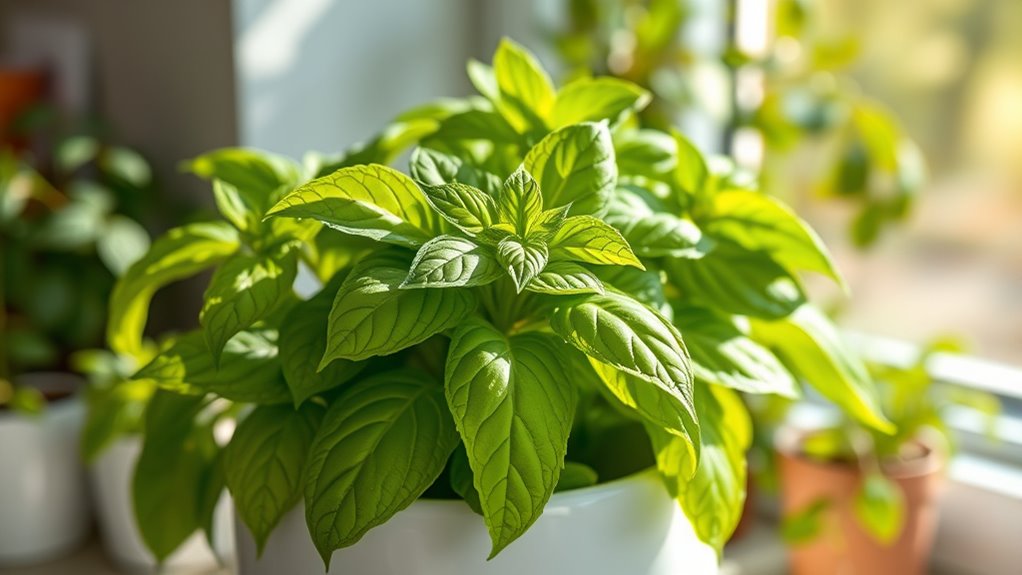
Basil is an easy herb to grow indoors when it receives plenty of sunlight, ideally at least six hours a day near a south-facing window.
To successfully grow basil indoors, use well-draining soil and a pot with drainage holes to prevent overwatering. Keep the soil consistently moist but not waterlogged.
Basil responds well to regular trimming, which encourages bushier growth and delays flowering, maintaining its flavor. You can start basil from seeds or purchase starter plants, and it often reaches harvest readiness in 4-6 weeks.
During winter, supplement natural light with grow lights to keep your basil healthy and vibrant.
With proper care, basil thrives as one of the easiest herbs indoors, providing fresh leaves year-round.
Oregano
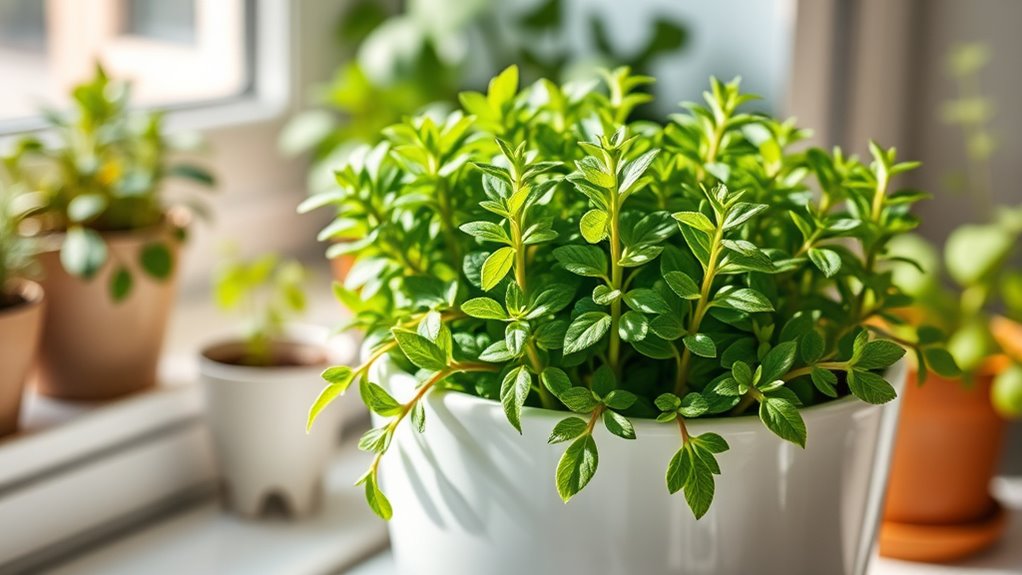
After mastering the basics of growing basil indoors, you might want to expand your herb garden with another versatile and hardy option: oregano. As one of the easiest herbs to grow indoors, oregano thrives in well-drained soil and needs full sunlight—preferably from south- or west-facing windows.
This perennial herb requires minimal watering; let the top inch of soil dry out between waterings to prevent overwatering. Regular trimming encourages bushy growth and prevents it from becoming leggy.
Propagation is straightforward—grow oregano from cuttings or buy young plants to get started. Its aromatic flavor makes it a popular addition to Italian dishes, sauces, and marinades.
With proper care, oregano will provide fresh herbs year-round, enriching your kitchen effortlessly.
Sage

Sage is a hardy perennial herb that thrives indoors when it receives plenty of bright, direct sunlight, preferably from south-facing windows. To succeed with indoor gardening, use well-drained soil, such as sandy or rocky mixes, and avoid overwatering to prevent root rot. Regular pruning encourages bushier herb plants and prevents the sage from becoming woody. You can grow sage up to 2.5 feet tall and wide in containers on your windowsill or in pots. Its aromatic leaves are perfect for culinary use year-round. For easy herb cultivation, ensure your sage gets enough light and prune back frequently to maintain healthy growth.
| Aspect | Details | Tips |
|---|---|---|
| Light | Bright, direct sunlight from south-facing windows | Use grow lights if needed |
| Soil | Well-drained, sandy or rocky soil | Add sand or gravel |
| Watering | Minimal once established | Avoid overwatering |
| Pruning | Regularly to promote bushiness | Use clean, sharp tools |
| Height & Width | Up to 2-2.5 feet | Container size matters |
Bay Laurel
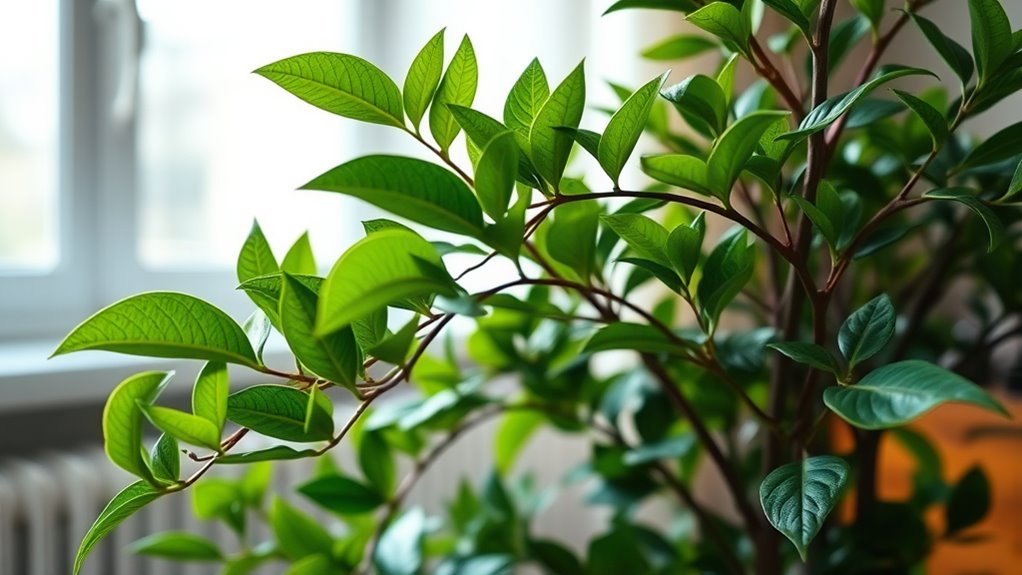
If you want to grow bay laurel indoors, you’ll need to provide it with plenty of bright, direct sunlight from south-facing windows, as this herb thrives in warm, sunny spots.
Bay laurel is an excellent choice for indoor herb growing because it can be kept in a container and managed with regular pruning. Make certain the plant is in well-drained, slightly acidic soil to prevent overwatering and root rot.
Good air circulation is essential to keep the plant healthy and reduce fungal risks. Be mindful of temperature sensitivity; keep your bay laurel away from cold drafts and maintain a stable, warm environment.
Frequently Asked Questions
What Herbs Can You Grow Indoors Year Round?
You can grow herbs like mint, chives, parsley, thyme, and lemon balm indoors all year. These herbs tolerate lower light and need minimal care.
With proper watering and drainage, oregano, sage, and rosemary also thrive indoors. Make sure they get enough bright light or use grow lights, especially in winter.
Regular pruning keeps them healthy and productive, so you’ll always have fresh herbs on hand, no matter the season.
What Are the Easiest Herbs to Grow Indoors?
You might think growing herbs indoors is complicated, but some are surprisingly easy. Herbs like mint, chives, parsley, thyme, and basil require minimal effort and thrive with just a few hours of sunlight.
They love well-draining soil and regular pruning, making them perfect for beginners.
With a bit of attention, you can enjoy fresh herbs year-round, right on your windowsill, without much fuss or specialized skills.
What Are the Best Herbs to Grow for Beginners?
If you’re starting an indoor herb garden, choose herbs like basil, parsley, chives, mint, and thyme. They’re perfect for beginners because they’re easy to care for, forgiving of watering mistakes, and thrive in well-draining soil with at least six hours of sunlight daily.
Regular pruning keeps them healthy and productive. These hardy herbs give you quick, satisfying results, boosting your confidence to grow more herbs indoors.
What Herbs Should Not Be Grown Indoors?
Thinking of turning your home into an herb jungle? Better skip herbs like basil and cilantro—they hate low light and cold, so they’ll just sulk and die.
Avoid delicate herbs like tarragon and lemon verbena, plus those needing outdoor airflow, like dill and fennel.
Woody herbs such as rosemary or bay laurel also struggle indoors, becoming root-bound or pale.
Save yourself the frustration and choose herbs suited for your indoor space.
Conclusion
Growing herbs indoors is like tending a little garden oasis in your home. I once started with just a few pots, and now my kitchen smells like a fresh herb market year-round. These ten herbs are so easy to care for, they almost grow themselves. Imagine having a mini herb farm right on your windowsill—fresh, fragrant, and always within reach. With a little attention, you’ll turn your space into a lush, flavorful sanctuary you’ll love to nurture.


